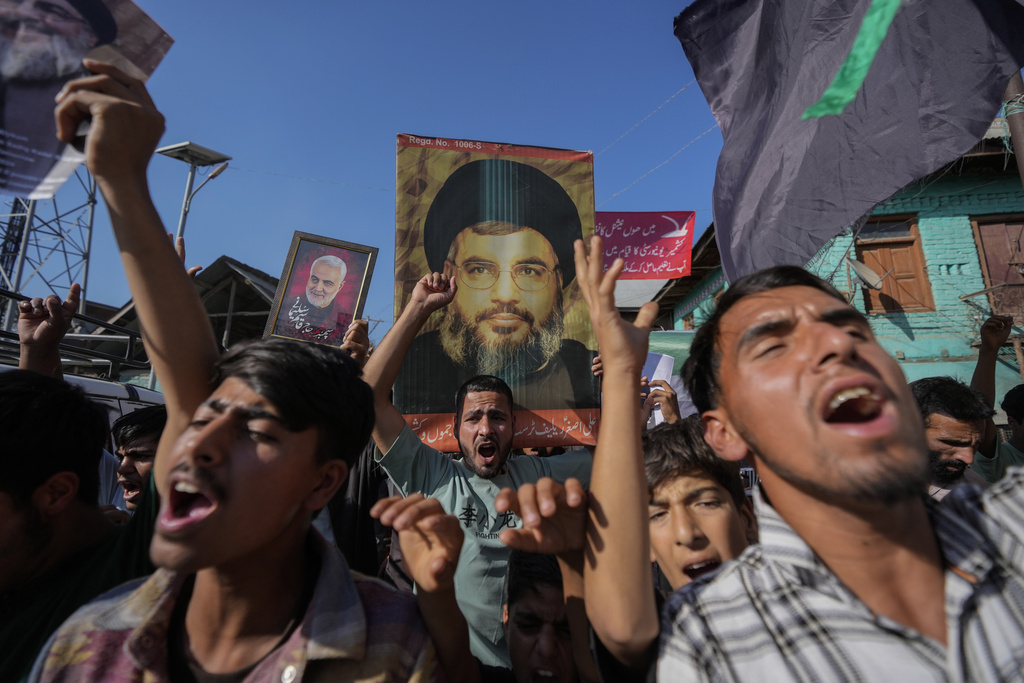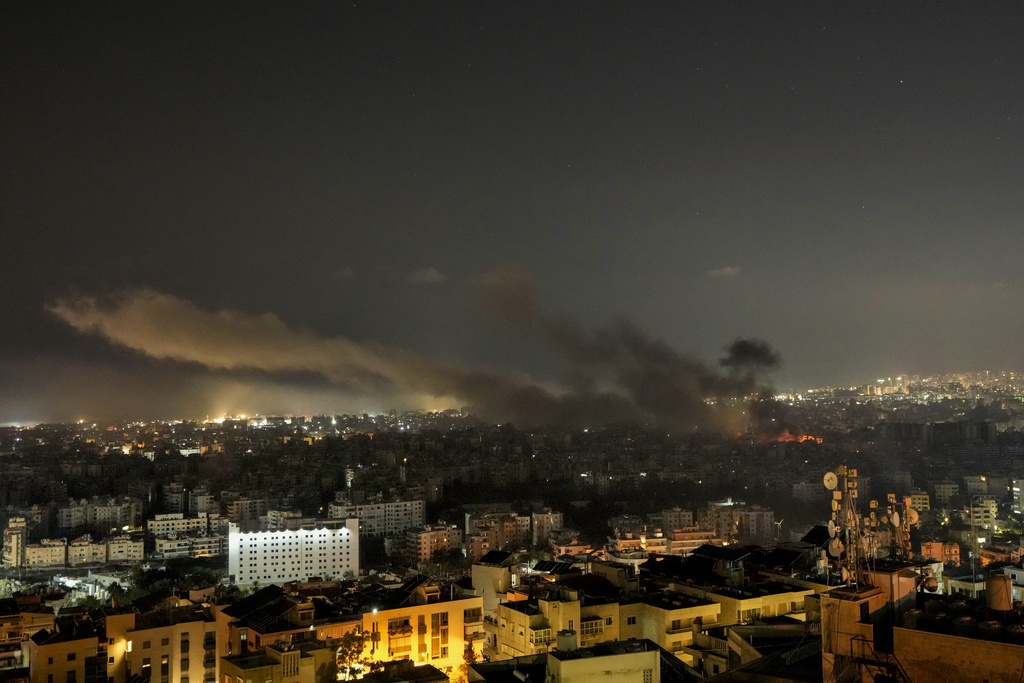Israeli Strikes Hit Refugee Camp, Killing Hamas Leader’s Family \ Newslooks \ Washington DC \ Mary Sidiqi \ Evening Edition \ An Israeli airstrike targeted a refugee camp in northern Lebanon, killing Hamas military official Saeed Atallah Ali and his family. The attack on the Beddawi camp marks the latest escalation in the broader Israeli-Hezbollah conflict. This strike comes amid ongoing hostilities that have seen heavy casualties across Gaza and Lebanon, including numerous militant leaders.

Hamas Official Death Quick Looks
- Attack Details: Israeli airstrike hits Beddawi refugee camp in northern Lebanon, killing a Hamas official.
- Victims Identified: Saeed Atallah Ali, a Qassam Brigades leader, his wife, and two daughters were killed.
- Additional Casualty: Another Hamas military wing member, Mohammed Lweis, killed in Bekaa Valley attack.
- Escalating Conflict: Continued Israeli-Hezbollah hostilities; frequent airstrikes since the October 2023 conflict escalation.
- Regional Fallout: Over 41,000 Palestinians killed in Gaza, and nearly 2,000 people killed in Lebanon since September.
Deep Look
An Israeli airstrike on a refugee camp in northern Lebanon has led to the death of a senior Hamas military official and his family, Hamas reported on Saturday. The targeted strike hit the Beddawi refugee camp, located near Tripoli, killing Saeed Atallah Ali, a commander with Hamas’s Qassam Brigades, along with his wife Shaymaa Azzam and their daughters, Zeinab and Fatima. The attack, the first recorded strike on Beddawi camp during the recent upsurge in violence, adds a significant new chapter to the escalating cross-border conflict between Israel, Hamas, and Hezbollah.
This strike is part of a larger pattern of intensified military actions that have engulfed the region since October 2023, when hostilities between Israel and Hamas spiraled into a broader conflict affecting Lebanon and Syria. Just hours after the Beddawi strike, Hamas reported that another military member, Mohammed Lweis, was killed in a separate Israeli attack in the eastern Lebanese Bekaa Valley, specifically targeting the village of Fayda.
Conflict Background: Escalation Since October 2023
The intensification of Israeli attacks on Hamas and Hezbollah positions in Lebanon comes as part of a wider military effort initiated by Israel following Hamas’s major cross-border assault on October 7, 2023. That attack, which resulted in the deaths of 1,200 Israelis and the abduction of over 250 hostages, sparked an immediate and overwhelming response from Israel, leading to an all-out war against Hamas in Gaza and, subsequently, escalating tensions with Hezbollah in Lebanon. Hezbollah, an Iran-backed militant group, began a nearly daily exchange of fire with Israeli forces following the outbreak of hostilities, effectively opening a second front along Israel’s northern border.
As the conflict has intensified, the toll on civilian life has become increasingly dire. The Lebanese Health Ministry has reported nearly 2,000 deaths in Lebanon since the renewed escalation of hostilities in late September, a mix of Hezbollah fighters and civilians. The Israeli military has focused its efforts on degrading Hezbollah’s capabilities, including targeting weapons storage facilities, missile launchpads, and key infrastructure, as well as destroying tunnel networks along the Lebanese border.
Destruction of Hezbollah Tunnels and Continued Ground Raids
Israel has undertaken a significant military operation to undermine Hezbollah’s strategic positions in southern Lebanon. On Saturday, the Israeli military revealed that it had discovered and destroyed a 250-meter-long tunnel used by Hezbollah near the Israel-Lebanon border. The tunnel contained a substantial stockpile of weapons, combat packs, and operational command centers, as well as living accommodations complete with showers and a kitchen. The military reported that while this tunnel did not penetrate Israeli territory, it demonstrated the extent of Hezbollah’s underground infrastructure.
Israeli special forces have conducted numerous ground raids against Hezbollah, focusing on the destruction of critical assets such as watchtowers, tunnel shafts, and missile launchpads. The objective, as stated by Israeli military officials, is to cripple Hezbollah’s ability to mount offensive operations and to force their fighters away from the immediate border region. During these ground operations, nine Israeli soldiers have died in intense combat, highlighting the complexity and danger of these missions in an area heavily fortified and densely mined by Hezbollah.
Civilian Casualties and Humanitarian Crisis
The human toll of the ongoing conflict has been staggering. According to health officials, more than 41,000 Palestinians have died since the conflict began, with children and women making up more than half of the victims. The fighting has led to a massive displacement crisis in Gaza, with most of the 2.3 million residents forced to flee their homes, often multiple times. Hundreds of thousands now reside in makeshift tent camps throughout the territory, enduring unsanitary conditions, food scarcity, and constant bombardment.
In Lebanon, the number of casualties continues to rise, and nearly 2,000 individuals have lost their lives in just over a month. The Israeli airstrikes have not only targeted Hezbollah positions but have also hit civilian areas and crucial infrastructure, including hospitals and medical facilities. Thousands of civilians have been caught in the crossfire, contributing to a worsening humanitarian situation. Nearly 375,000 people have fled Lebanon for Syria over the last two weeks, according to the Lebanese government’s crisis management unit, seeking safety across the border despite the risks posed by the continuing bombardments.
International Evacuations Amid Conflict
Amid the intensifying conflict, countries worldwide have been evacuating their nationals and residents from Lebanon. Brazil, Slovakia, and South Korea have all initiated evacuation missions. A Brazilian Air Force-chartered flight left Beirut for Sao Paulo on Saturday, carrying 229 passengers, including 10 infants and three pets. A second Brazilian evacuation flight is planned, contingent on the security situation on the ground. Slovakia also evacuated 46 individuals to Bratislava, with a second flight scheduled later in the day. South Korea’s Foreign Ministry reported the arrival of a military plane carrying 97 evacuees, including South Korean nationals and their family members.
Evacuation operations have been fraught with complications. For instance, the Brazilian flight faced delays due to the precarious security situation in Lebanon. Similar operations are being coordinated by other countries, with military aircraft used to move evacuees first to nearby locations like Larnaca, Cyprus, before completing the journey to their home countries.
Diplomatic Efforts: Iran’s Call for Cease-Fire
Diplomatic efforts to end the hostilities have been inconsistent but persistent. Iranian Foreign Minister Abbas Araghchi, during a press conference in Damascus, hinted that several nations are working behind the scenes to broker cease-fires in both Gaza and Lebanon. While he did not name the countries involved, he indicated that these efforts span both regional and international actors. Araghchi stressed that any peace proposal would need the acceptance of Palestinian and Lebanese representatives before receiving support from Iran and Syria. He reiterated Iran’s resolve to retaliate against any Israeli aggression, asserting that Iran’s response would be robust, and the world could “test their will.”
Iran has been a central supporter of Hezbollah and Hamas, and the country’s backing plays a crucial role in the ongoing conflict. Syrian President Bashar Assad echoed similar sentiments during a meeting with Araghchi, praising Iran for firing nearly 200 missiles at Israel earlier in the week. Assad reaffirmed that resisting occupation is a “legitimate right” and emphasized that the alliance known as the Axis of Resistance remains resilient due to the unwavering support of its people.
Regional Strikes and Widening Fronts
In Syria, the conflict has also seen spillover impacts, with Israeli strikes targeting locations associated with Iranian-backed groups. On Saturday, a drone attack struck a car near the central city of Hama, killing one person and wounding three others. The incident, reported by the Syrian Observatory for Human Rights, is one of many strikes Israel has conducted within Syrian territory, often targeting weapons shipments or militant personnel. The Israeli government has rarely commented on these operations but maintains that such strikes are necessary to prevent arms proliferation to Hezbollah and other allied groups.
Rocket alert sirens have sounded repeatedly across northern Israel in recent days, with approximately 90 rockets fired from Lebanon on Saturday alone. While most projectiles were intercepted or landed in unpopulated areas, a few rockets caused injuries and damage in residential locations, such as the Arab town of Deir al-Asad and the nearby city of Karmiel. The frequent rocket fire adds to the sense of fear and instability throughout the region, particularly for civilians living near the border.
Conclusion: The Path Ahead
The violent exchanges between Israel, Hamas, and Hezbollah show few signs of easing. As the conflict moves into its second year, the impact on the region’s civilian population is devastating and widespread. Humanitarian organizations have struggled to keep up with the overwhelming needs for food, shelter, and medical assistance as populations across Gaza, Lebanon, and Syria bear the brunt of the hostilities. With international diplomatic efforts yet to yield a significant breakthrough, millions remain displaced and caught in a rapidly worsening humanitarian catastrophe.
Israeli Strikes Hit Israeli Strikes Hit Israeli Strikes Hit Israeli Strikes Hit







